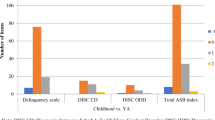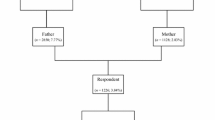Abstract
Twenty-eight factor- and cluster-analytic studies of child psychopathology were examined for patterns in antisocial behavior. A multidimensional scaling analysis yielded one dimension that was labeled overt-covert antisocial behavior. One end of this dimension consisted of overt or confrontive antisocial behaviors such as arguing, temper tantrums, and fighting. The other end consisted of covert or concealed antisocial behaviors such as stealing, truancy, and fire setting. Implications derived from the present findings are discussed as they apply to the diagnosis, prevention, and treatment of antisocial behaviors in children.
Similar content being viewed by others
References
Achenbach, T. M. (1966). The classification of children's psychiatric symptoms: A factor analytic study.Psychological Monographs, 80(7, Whole No. 615).
Achenbach, T. M. (1978). The child behavior profile: I. Boys aged 6–11.Journal of Consulting Psychology, 46, 478–488.
Achenbach, T. M., & Edelbrock, C. S. (1978). The classification of child psychopathology: A review and analysis of empirical efforts.Psychological Bulletin, 85, 1275–1301.
Achenbach, T. M., & Edelbrock, C. S. (1979). The child behavior profile: II. Boys aged 12–16 and girls aged 6–11 and 12–16.Journal of Consulting and Clinical Psychology, 47, 223–233.
Achenbach, T. M., & Edelbrock, C. S. (1983).Manual for the Child Behavior Checklist and Revised Child Behavior Profile. Burlington, Vermont.
American Psychiatric Association (1968).Diagnostic and statistical manual of mental disorders (2nd ed.). Washington, D.C.: Author.
American Psychiatric Association (1980).Diagnostic and statistical manual of mental disorders. (3rd ed.). Washington, D.C.: Author.
Arnold, L. E., & Smeltzer, D. J. (1974). Behavior checklist factor analysis for children and adolescents.Archives of General Psychiatry, 30, 799–804.
Chamberlain, P. (1980).Standardization of a parent report measure. Unpublished doctoral dissertation, University of Oregon.
Conners, C. K. (1970). Symptom patterns of hyperkinetic, neurotic, and normal children.Child Development, 41, 667–682.
Dreger, R. M. (1981). The classification of children and their emotional problems.Clinical Psychology Review, 1, 415–430.
Dreger, R. M. (1982). The classification of children and their emotional problems: An overview. II.Clinical Psychology Review, 2, 349–386.
Dreger, R. M., & Dreger, G. E. (1962).Behavior classification project, Report No. 1. Unpublished manuscript, Jacksonville University.
Dreger, R. M., Reid, M. P., Lewis, P. M., Overlade, D. C., Rich, T. A., Taffei, C., Miller, K. S., & Flemming, E. L. (1964). Behavior classification project.Journal of Consulting Psychology, 28, 1–13.
Edelbrock, C. S., & Achenbach, T. M. (1980). A typology of child behavior profile patterns: Distribution and correlates for disturbed children aged 6–16.Journal of Abnormal Child Psychology, 8, 441–470.
Gibbons, D. C. (1975). Offender typologies — Two decades later.British Journal of Criminology, 15, 140–156.
Glow, R. A. (1981). Cross-validity and normative data on the Conners parent and teacher rating scales. In K. D. Gadow & J. Loney (Eds),The psychosocial aspects of drug treatment for hyperactivity (pp. 107–150). Boulder, Colorado: A.A.A.S. and Westview Press.
Goyette, C. H., Conners, C. K., Ulrich, R. F. (1978). Normative data on revised Conners Parent and Teacher Rating Scales.Journal of Abnormal Child Psychology, 6, 221–236.
Herbert, M. Conduct disorders. (1982). In B. B. Lahey & A. E. Kazdin (Eds.),Advances in clinical child psychology (Vol. 5, pp. 95–136). New York: Plenum Press.
Hetherington, E. M., & Martin, B. (1979). Family interaction. In H. C. Quay & J. S. Werry (Eds.),Psychopathological disorders of childhood (2nd ed., pp. 247–302). New York: Wiley.
Hewitt, L. E., & Jenkins, R. L. (1946).Fundamental patterns of maladjustment: The dynamics of their origin. Michigan Child Guidance Institute.
Hirshoren, A., & Schnittjer, C. J. (1979). Dimensions of problem behavior in deaf children.Journal of Abnormal Child Psychology, 7, 221–228.
Hood, R., & Sparks, R. (1970).Key issues in criminology. London: Weindenfeld & Nicholson.
Jenkins, R. L. (1966). Psychiatric syndromes in children and their relationship to family background.American Journal of Orthopsychiatry, 36, 450–457.
Jenkins, R. L. (1968). The varieties of adolescents' behavioral problems and family dynamics. In S. J. Shamsie (Ed.),Adolescent psychiatry: Proceedings of a conference held at Douglas Hospital, Montreal, Quebec, June 1967 (pp. 10–24). Montreal, Canada: Shering.
Jenkins, R. L., & Glickman, S. (1946). Common syndromes in child psychiatry.American Journal of Orthopsychiatry, 16, 244–253.
Jenkins, R. L., NurEddin, E., & Shapiro, I. (1966). Children's behavior syndromes and parental responses.Genetic Psychology Monographs, 74, 261–329.
Johnson, R. E. (1979).Juvenile delinquency and its origins. Cambridge: Cambridge University Press.
Kara, A., & Wahler, R. G. (1977). Organizational features of a young child's behaviors.Journal of Experimental Child Psychology, 24, 24–39.
Kohlberg, L., LaCrosse, J.,& Ricks, D. (1972). The predictability of adult mental health from childhood behavior. In B. B. Wolman (Ed.),Manual of child psychopathology (pp. 1217–1284). New York: McGraw-Hill.
Kruskal, J. B. (1964). Nonmetric multidimensional scaling.Psychometrika, 29, 115–129.
Lachar, D., & Gdowski, C. L. (1979). Problem-behavior factor correlates of Personality Inventory for Children Profile Scales.Journal of Consulting and Clinical Psychology, 47, 39–48.
LaGreca, A. M., & Quay, H. C. (1984). Behavior disorders of children. In N. S. Endler & J. McV. Hunt (Eds.),Personality and behavior disorders (2nd ed.) New York: Wiley.
Langner, T. S., Gersten, J. C., Wills, T. A., & Simcha-Fagan, O. (1983). The relative roles of early environment and early behavior as predictors of later child behavior. In D. F. Ricks & B. S. Dohrenwend (Eds.),Origins of psychopathology (pp. 43–72). New York: Cambridge University Press.
Lessing, E. E. (1983). [Results from factor analysis.] Unpublished data analysis. Chicago: Institute for Juvenile Research.
Lessing, E. E., Black, M., Barbera, L., & Seibert, F. (1976). Dimensions of adolescent psychopathology and their prognostic significance for treatment outcome.Genetic Psychology Monographs, 93, 155–168.
Lessing, E. E., Williams, V., & Gil, E. (1982). A cluster-analytically derived typology: Feasible alternative to clinical diagnostic classification of children.Journal of Abnormal Child Psychology, 10, 451–482.
Lessing, E. E., & Zagorin, S. W. (1971). Dimensions of psychopathology in middle childhood as evaluated by three symptom checklists.Educational and Psychological Measurement, 31, 175–198.
Lewis, H. G. (1954).Deprived children. London: Oxford University Press.
Loeber, R., & Schmaling K. B. (1982). [Results from factor analysis.] Unpublished data analysis.
Loevinger, J. (1966). The meaning and measurement of ego development.American Psychologist, 21, 195–206.
Loney, J., Langhorne, J. E., & Paternite, C. E. (1978). An empirical basis for subgrouping the hyperkinetic/minimal brain dysfunction syndrome.Journal of Abnormal Psychology, 87, 431–441.
Lorr, M., & Jenkins, R. L. (1953). Patterns of maladjustment in children.Journal of Clinical Psychology, 9, 16–19.
McDermott, P.A. (1982). Generality of disordered behavior across populations of normal and deviant school children: Factorial relations analyses.Multivariate Behavioral Research, 17, 69–85.
Miller, L. C. (1967a). Louisville Behavior Checklist for males, 6–12 years of age.Psychological Reports, 21, 885–896.
Miller, L. C. (1967b). Dimensions of psychopathology in middle childhood.Psychological Reports, 21, 897–903.
O'Leary, S. G., & Steen, P. L. (1982). Subcategorizing hyperactivity: The Stony Brook Scale.Journal of Consulting and Clinical Psychology, 50, 426–532.
Patterson, G. R. (1982).A social learning approach, Vol. 3: Coercive family process. Eugene, Oregon: Castalia.
Quay, H. C. (1964). Dimensions of personality in delinquent boys as inferred from the factor analysis of case history data.Child Development, 35, 479–484.
Quay, H. C. (1966). Personality patterns in pre-adolescent boys.Educational Psychology Measurement, 26, 99–110.
Quay, H. C. Classification. (1979). In H. C. Quay & J. S. Werry (Eds.),Psychopathological disorders of childhood (2nd ed., pp. 1–42). New York: Wiley.
Quay, H. C., & Peterson, D. R. (1983).Interium manual for the Revised Behavior Problem Checklist. Unpublished manual, University of Miami.
Reid, J. B., & Hendriks, A. F. C. J. (1973). A preliminary analysis of the effectiveness of direct home intervention for treatment of pre-delinquent boys who steal. In L. A. Hamerlynck, L. C. Handy, & E. J. Mash (Eds.),Behavior therapy: Methodology, concepts, and practice (pp. 209–220). Champaign, Illinois: Research Press.
Reid, J. B., & Patterson, G. R. (1976). Follow-up analyses of a behavioral treatment program for boys with conduct problems: A reply to Kent.Journal of Consulting and Clinical Psychology, 44, 297–302.
Robins, L. N. (1966).Deviant children grown up: A sociological and psychiatric study of sociopathic personality. Baltimore: Williams & Wilkins.
Robins, L. N., & Ratcliff, K. S. (1980). Childhood conduct disorders and later arrest. In L. N. Robins, P. Clayton, & J. Wing (Eds.),Social consequences of psychiatric illness (pp. 248–263). New York: Brunner/Mazel.
Rojek, D. G., & Erickson, M. L. (1982). Delinquent careers: A test of the career escalation model.Criminology, 20, 5–28.
Russo, D. C., Cataldo, M. F., & Gushing, P. J. (1981). Compliance training and behavioral covariation in the treatment of multiple behavior problems.Journal of Appied Behavior Analysis, 14, 209–222.
Sameroff, A. J., & Chandler, M. J. (1975). Reproductive risk and the continuum of caretaking casualty. In F. D. Horowitz, M. Hetherington, S. Scarr-Salapatck, & G. M. Siegel (Eds.),Review of child developmental research (Vol. 4, pp. 187–244). Chicago: University of Chicago Press.
Short, J. F., Tennyson, R. A., & Howard, K. I. (1963). Behavior dimensions of gang delinquency.American Sociological Review, 28, 411–428.
Simcha-Fagan, O., Langner, T. S., Gersten, J. C., & Eisenberg, J. G. (1975).Violent and antisocial behavior: A longitudinal study of urban youth. Unpublished report of the Office of Child Development, OCD-CB-480.
Snyder, D. K., Lachar, D., & Gdowski, C. L. (1982).External validation of the Personality Inventory for Children (PIC) factor scales: Parent, teacher and clinician ratings. Unpublished manuscript, Lafayette Clinic, Detroit, Michigan.
Stewart, M. A., deBlois, C. S., & Cummings, C. (1980). Psychiatric disorder in the parents of hyperactive boys and those with conduct disorder.Journal of Child Psychology and Psychiatry, 21, 283–292.
Thoresen, C. E., & Mahoney, M. J. (1974).Behavioral self-control. New York: Holt, Rinehart & Winston.
Trites, R. L., & Laprade, K. (1983). Evidence for an independent syndrome of hyperactivity.Journal of Child Psychology and Psychiatry, 24, 573–586.
Voeltz, L. M., & Evans, I. M. (1982). The assessment of behavioral inter-relationships in child behavior therapy.Behavioral Assessment, 4, 131–165.
Wahler, R. G. (1975). Some structural aspects of deviant child behavior.Journal of Applied Behavior Analysis, 8, 27–42.
Whitman, T. L., Hurley, J. D., Johnson, M. R., & Christian, J. G. (1978). Direct and generalized reduction of inappropriate behavior in a severely retarded child through a parent-administered behavior modification program.AAESPH Review, 3, 68–77.
Wolff, S. (1971). Dimensions and clusters of symptoms in disturbed children.British Journal of Psychiatry, 118, 421–427.
Wolfgang, M. E., Figlio, R. M., & Sellin, T. (1972).Delinquency in a birth cohort. Chicago: University of Chicago Press.
Young, F. W., & Lewyckyj, R. (1980). ALSCAL. In P. S. Reinhardt (Ed.),The SAS supplemental library user's guide, 1980 (pp. 15–25). Cary, North Carolina: SAS Institute.
Yule, W. (1981). The epidemiology of child psychopathology. In B. B. Lahey & A. E. Kazdin (Eds.),Advances in clinical child psychology (Vol. 4, pp. 1–51). New York: Plenum Press.
Author information
Authors and Affiliations
Additional information
The authors are indebted to Drs. C. Edelbrock, B. Fagot, L. Goldberg, and H. C. Quay for their advice during the writing of this paper. Special thanks are extended to Drs. L. Furby, J. B. Reid, G. R. Patterson, and M. Stouthamer-Loeber, who read and criticized earlier drafts of this paper. The authors also acknowledge the helpful comments and inspiration they received from staff at the Oregon Social Learning Center. The paper was written with the financial assistance of Grant No. MH 32857 from the Center of Studies in Crime and Delinquency, National Institute of Mental Health.
Rights and permissions
About this article
Cite this article
Loeber, R., Schmaling, K.B. Empirical evidence for overt and covert patterns of antisocial conduct problems: A metaanalysis. J Abnorm Child Psychol 13, 337–353 (1985). https://doi.org/10.1007/BF00910652
Revised:
Issue Date:
DOI: https://doi.org/10.1007/BF00910652




